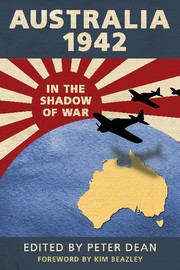Book contents
- Frontmatter
- Foreword
- Contents
- Photos
- Maps
- Charts
- Acknowledgements
- Contributors
- Abbreviations
- Maps
- Introduction
- Part 1 Australia in 1942
- Part 2 Relations, politics and the home front
- Part 3 Australia under threat
- Part 4 The war on Australia’s doorstep
- Chapter 9 Vanquished but defiant, victorious but divided
- Chapter 10 A novel experience
- Chapter 11 On Australia’s doorstep
- Chapter 12 Anzacs and Yanks
- Conclusion
- Index
- References
Chapter 9 - Vanquished but defiant, victorious but divided
The RAAF in the Pacific, 1942
from Part 4 - The war on Australia’s doorstep
Published online by Cambridge University Press: 05 January 2013
- Frontmatter
- Foreword
- Contents
- Photos
- Maps
- Charts
- Acknowledgements
- Contributors
- Abbreviations
- Maps
- Introduction
- Part 1 Australia in 1942
- Part 2 Relations, politics and the home front
- Part 3 Australia under threat
- Part 4 The war on Australia’s doorstep
- Chapter 9 Vanquished but defiant, victorious but divided
- Chapter 10 A novel experience
- Chapter 11 On Australia’s doorstep
- Chapter 12 Anzacs and Yanks
- Conclusion
- Index
- References
Summary
When the RAAF was created in 1921, the threat that had been the chief justification for its creation was Japan. Yet, when Japan finally went to war with Australia, 20 years later, the RAAF was not ready for that challenge. What might be called a thin blue line of Australian airfields had been drawn on a great arc running from Malaya and Singapore, the supposed British forward defence of Australia in the west, via the Dutch East Indies through mainland New Guinea to New Britain and New Ireland in the East. The Australian aircraft that flew to those airfields early in 1942 were for the most part inferior to their Japanese opponents in quality and quantity. Japan’s entry into the war imposed additional burdens on an air force already straining to meet its commitments to help the Royal Air Force in the war against Germany. There were extra burdens in the way of commonplace, boring but vital work – such as escorting ships from Australia to the outlying islands where the Australian government hoped to contain and then defeat the Japanese. Work such as hunting for Japanese submarines, and reconnaissance work over enemy bases and potential landing places. The air battles were most glamorous and decisive, but it is important to note that in 1942 the air force undertook an immense amount of unglamorous, unsung and indispensable work.
‘No show at all’
By New Year’s Day 1942, the RAAF had already been heavily engaged against the Japanese for more than three weeks. Hours before the Pearl Harbor raid began, Hudson aircraft of No. 1 Squadron RAAF had been fighting a Japanese invasion force at Kota Bharu, in northern Malaya. They had sunk a ship and inflicted many casualties that day, but had not been able to prevent the Japanese from coming ashore. In the weeks following, No. 1 and the three other Australian squadrons in Malaya, together with fewer than a dozen RAF squadrons had tried, against odds of about 4-to-1 to contest air superiority over Malaya and Singapore and to stem the Japanese advance on the ground. Losses among the Australian fighter squadrons, Nos 21 and 453, had been so heavy that in late December the two had amalgamated. Their losses owed much to the inadequacy of their aircraft, the Brewster Buffalo.
- Type
- Chapter
- Information
- Australia 1942In the Shadow of War, pp. 161 - 178Publisher: Cambridge University PressPrint publication year: 2012



